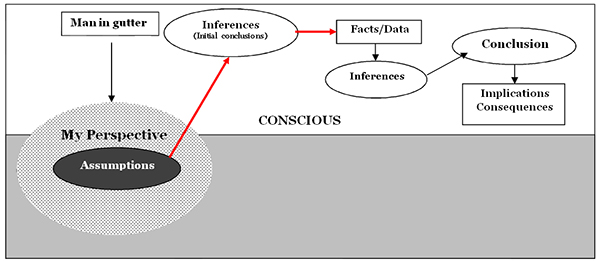The Hidden Power of Perspective and Assumptions
Perspective: context or reference from which to sense, categorize, measure or codify experience.
Assumption: something taken for granted or believed to be true without proof.
Inference: logical conclusion from a premise, whether the premise is a fact or assumption.
Proceed with caution: perspective and assumptions frequently operate in a subconscious zone. As long as they remain subconscious, you have no way of recognizing their impact on your thinking and decisions.
Consider this example: You see a man lying in the gutter. Before you have time to gather additional facts, your brain is already trying to make sen¬se ofwhat it sees, to connect it to some context or reference. Your perspective supplies your brain with ready-made assumptions— instantaneous prejudgments such as: Men who lie in the gutter are bums.
Your conscious mind is not far behind. It instantly connects what it sees with the subconscious assumptions available to it. It draws immediate inferences such as: That man is a bum.
Suppose you are with a friend when you see the man in the gutter. Your friend might have a different perspective. His subconscious assumption might be: Men who lie in the gutter need help.
His immediate inference would logically be: That man needs help.
Both inferences are logically drawn from their premises, but both premises are assumptions that may not be true. You probably learned at an early age to be cautious about placing too much trust in these immediate inferences: “Don’t jump to conclusions!”
But there is a more subtle problem. The inferences you draw from these assumptions limit the scope of the rest of your thinking. They reduce not only the universe of facts and data you will research but also your openness to some of the facts and data you find. This negatively affects everything downstream.
If, for instance, your inference, That man is a bum causes you to hurry by and not look more closely, you will miss some additional facts. The man is well-groomed and wearing a suit. His hip pocket is torn, and he has blood on his shirt. This would lead to some new inferences based on facts: He may be a robbery victim. This inference is likely to lead to a different conclusion.
The red arrows above indicate the most vulnerable elements of this problem of perspective and assumptions. And all thinking has this problem. Critical thinking exposes it and calls into question the subconscious elements so we can minimize their hidden power.
Here are some common perspective distortions that critical thinking exposes. Paul and Elder1 refer to them as “the most commonly used psychological standards in human thinking.”
Critical thinking protects your decisions and their consequences by requiring careful scrutiny of your perspective and all assumptions.
1 Paul, Dr. Richard; Elder, Dr. Linda. (2002) Critical Thinking. New Jersey: Financial Times Prentice Hall, p. 158

